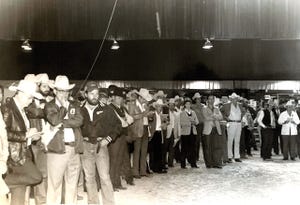Drought Skewing Cattle Estimates
"The driest year since the dinosaurs roamed the Lone Star State has completely thrown analysts for a loop, as they continue to unsuccessfully try to get a handle on the number of displaced drought cattle moving into the feedlot," explained folks with the Agricultural Marketing Service (AMS) Friday.
July 26, 2011

"The driest year since the dinosaurs roamed the Lone Star State has completely thrown analysts for a loop, as they continue to unsuccessfully try to get a handle on the number of displaced drought cattle moving into the feedlot," explained folks with the Agricultural Marketing Service (AMS) Friday.
That comment was made in reference to the July's Cattle on Feed report released Friday. June placements were pegged at 1.70 million head or 4% higher than a year ago. That was 3% higher than the most pessimistic guess and about 10% higher than the average. Total cattle on feed July 1 was also pegged 4% higher than a year ago at 10.5 million head; that’s within a couple of percentage points of the average guess. June marketings came in stronger than most estimates at 2.10 million head, 5% more than a year earlier.
Though the numbers may be another surprise – May's report was as bearish as June's was bullish – such swings and uncertainty can't be shocking. After all, there’s a shortage of trucks and you have to schedule a slot at the sale barn to sell cattle because so many are moving through auction in such a short period of time. That's what's been happening the last several weeks with both drought and record-high prices pushing cattle to market. The price impetus faded fast last week (see "Heat and Sell-Off Pound Markets").
"They're culling a lot deeper than they normally would, and they're culling a lot harder than they normally would, and they're culling into the heart of their herds," Rick Hirsch, Texas AgriLife Extension agent in Henderson County, explained last week. "Statewide, I've been hearing huge numbers from auction markets in Central and West Central Texas."
Of course, that means fewer calves to background, stocker and feed for the next several years.
USDA's semi-annual Cattle Inventory report released Friday afternoon was less bullish that some had expected. it pegged total cattle inventory at 100 million head, 1% less than a year earlier. Beef cows are also down 1% at 31.4 million head; many pre-release estimates were guessing more like 2% or so. Beef replacements are down 5% at 4.2 million head; that was more than most pre-release estimates.
"The high rate of cow slaughter will likely limit calf crops for at least this year and next," explained analysts in the July Livestock, Dairy and Poultry Outlook (LDPO) released last week. "Many auction runs have included relatively large percentages of heifers, and it is likely that at least some of the heifers that had been retained for replacements have been sold in response to the drought-reduced forage supplies.
"Like cow prices, feeder-cattle prices have remained strong despite the lack of pasture and subsequent forced sales of feeder cattle from the southern part of the U.S. and Mexico," LDPO analysts explain. "Drought-induced feedlot placements of cattle have been at weights lighter than if there had been adequate grazing conditions. Lighter placement weights, falling feed prices, and expectations of reduced supplies of feeder cattle for feedlot placement over the next 2-3 years are providing support for current or higher price levels for feeder cattle."
When rain and grass do ultimately return, Hirsch notes it will likely be more difficult than in the past for producers to build numbers back. "We have higher cattle prices right now, and that is helping the situation. But the high cost of replacements, the cost of fertilizer and the cost of fuel, all will make it harder to build numbers back up."
About the Author(s)
You May Also Like


.png?width=300&auto=webp&quality=80&disable=upscale)


